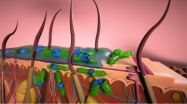(Press-News.org) Argonne, Ill.– Scientists succeeded in obtaining an unprecedented view of a type of brain-cell receptor that is implicated in a range of neurological illnesses, including Alzheimer's disease, Parkinson's disease, depression, schizophrenia, autism, and ischemic injuries associated with stroke.
The team of biologists at Cold Spring Harbor Laboratory used the U.S. Department of Energy's Advanced Photon Source at Argonne National Laboratory to get an atomic-level picture of the intact NMDA (N-methyl, D-aspartate) receptor should serve as template and guide for the design of therapeutic compounds.
The NMDA receptor is a massive multi- subunit complex that integrates both chemical and electrical signals in the brain to allow neurons to communicate with one another. These conversations form the basis of memory, learning, and thought, and critically mediate brain development. The receptor's function is tightly regulated: both increased and decreased NMDA activities are associated with neurological diseases.
Despite the importance of NMDA receptor function, scientists have struggled to understand how it is controlled. In work published recently in Science, CSHL Associate Professor Hiro Furukawa and Erkan Karakas, Ph.D., a postdoctoral investigator, use a type of molecular photography known as X-ray crystallography to determine the structure of the intact receptor. Their work identifies numerous interactions between the four subunits of the receptor and offers new insight into how the complex is regulated. The X-ray work was done with the National Institute for General Medical Sciences and National Cancer Institute Collaborative Access Team (GM/CA) beamline at the APS and a beamline at SPring 8.
"Previously, our group and others have crystallized individual subunits of the receptor – just fragments – but that simply was not enough," says Furukawa. "To understand how this complex functions you need to see it all together, fully assembled."
For such a large complex, this was a challenging task. Using an exhaustive array of protein purification methods, Furukawa and Karakas were able to isolate the intact receptor. Their crystal structure reveals that the receptor looks much like a hot air balloon. "The 'basket' is what we call the transmembrane domain. It forms an ion channel that allows electrical signals to propagate through the neuron," explains Furukawa.
An ion channel is like a gate in the neuronal membrane. Ions, small electrically charged atoms, are unable to pass through the cell membrane. When the ion channel "gate" is closed, ions congregate outside the cell, creating an electrical potential across the cell membrane.
When the ion channel "gate" opens, ions flow in and out of the cell through the channel pores. This generates an electrical current that sums up to create pulses that rapidly propagate through the neuron. But the current can't jump from one neuron to the next. Rather, the electrical pulse triggers the release of chemical messengers, called neurotransmitters. These molecules traverse the distance between the neurons and bind to receptors, such as the NMDA receptor, on the surface of neighboring cells. There, they act much like a key, unlocking ion channels within the receptor and propelling the electrical signal across another neuron and, ultimately, across the brain.
The "balloon" portion of the receptor that Furukawa describes is found outside the cell. This is the region that binds to neurotransmitters. The structure of the assembled multi-subunit receptor complex, including the elusive ion channel, helps to explain some of the existing data about how NMDA receptors function. "We are able to see how one domain on the exterior side of the receptor directly regulates the ion channel within the membrane," says Furukawa. "Our structure shows why this particular domain, called the amino terminal domain, is important for the activity of the NMDA receptor, but not for other related receptors."
This information will be critical as scientists work to develop drugs that control the NMDA receptor. "Our structure defines the interfaces where multiple subunits and domains contact one another," says Furukawa. "In the future, these will guide the design of therapeutic compounds to treat a wide range of devastating neurological diseases."
INFORMATION:This work was supported by the National Institutes of Health, a Mirus Research Award, and the Robertson Research Fund of Cold Spring Harbor Laboratory.
"Crystal structure of a heterotetrameric NMDA receptor ion channel" appears online in Science on May 30, 2014. The authors are Erkan Karakas and Hiro Furukawa. The paper can be obtained online at: http://www.sciencemag.org
The APS beamline is funded by the National Institutes of Health's National Institute of General Medical Sciences and the National Cancer Institute. The APS is funded by the U.S. Department of Energy's Office of Science.
Argonne National Laboratory seeks solutions to pressing national problems in science and technology. The nation's first national laboratory, Argonne conducts leading-edge basic and applied scientific research in virtually every scientific discipline. Argonne researchers work closely with researchers from hundreds of companies, universities, and federal, state and municipal agencies to help them solve their specific problems, advance America's scientific leadership and prepare the nation for a better future. With employees from more than 60 nations, Argonne is managed by UChicago Argonne, LLC for the U.S. Department of Energy's Office of Science.
The Advanced Photon Source at Argonne National Laboratory is one of five national synchrotron radiation light sources supported by the U.S. Department of Energy's Office of Science to carry out applied and basic research to understand, predict, and ultimately control matter and energy at the electronic, atomic, and molecular levels, provide the foundations for new energy technologies, and support DOE missions in energy, environment, and national security. To learn more about the Office of Science X-ray user facilities, visit the Office of Science website.
Cold Spring Harbor Laboratory, founded in 1890, has shaped contemporary biomedical research and education with programs in cancer, neuroscience, plant biology and quantitative biology. CSHL is ranked number one in the world by Thomson Reuters for the impact of its research in molecular biology and genetics. The Laboratory has been home to eight Nobel Prize winners. Today, CSHL's multidisciplinary scientific community is more than 600 researchers and technicians strong and its Meetings & Courses program hosts more than 12,000 scientists from around the world each year to its Long Island campus and its China center. For more information, visit http://www.cshl.edu.
Unprecedented detail of intact neuronal receptor offers blueprint for drug developers
2014-08-26
ELSE PRESS RELEASES FROM THIS DATE:
Yale journal explores advances in sustainable manufacturing
2014-08-26
In recent years, increasing pressure from policymakers, consumers, and suppliers has prompted manufacturers to set environmental targets that go beyond reducing the pollutants they emit from their smokestacks or discharge into rivers and lakes. Today companies must also assess environmental performance at every step in their process, from the mining of primary materials to the use and recycling of their products.
This perspective has given rise to the discipline known as life cycle engineering, which connects the engineers who grapple with the efficiencies of production ...
Composition of Earth's mantle revisited
2014-08-26
Research published recently in Science suggested that the makeup of the Earth's lower mantle, which makes up the largest part of the Earth by volume, is significantly different than previously thought.
Understanding the composition of the mantle is essential to seismology, the study of earthquakes and movement below the Earth's surface, and should shed light on unexplained seismic phenomena observed there.
Though humans haven't yet managed to drill further than seven and a half miles into the Earth, we've built a comprehensive picture of what's beneath our feet through ...
What can 14th century Venice teach us about Ebola and other emerging threats?
2014-08-26
The way in which the Italian city of Venice dealt with the outbreak of the plague in the fourteenth century holds lessons on how to even mitigate the consequences of today's emerging threats, like climate change, terrorism, and highly infectious or drug-resistant diseases. So says Dr. Igor Linkov of the US Army Engineer Research and Development Center, and a visiting professor of the Ca Foscari University in Italy. Linkov led an article on resilience management appearing in Springer's journal Environment Systems and Decisions.
Venice was the hub of many trade routes into ...
Sorting cells with sound waves
2014-08-26
CAMBRIDGE, MA -- Researchers from MIT, Pennsylvania State University, and Carnegie Mellon University have devised a new way to separate cells by exposing them to sound waves as they flow through a tiny channel. Their device, about the size of a dime, could be used to detect the extremely rare tumor cells that circulate in cancer patients' blood, helping doctors predict whether a tumor is going to spread.
Separating cells with sound offers a gentler alternative to existing cell-sorting technologies, which require tagging the cells with chemicals or exposing them to stronger ...
Introducing the multi-tasking nanoparticle
2014-08-26
(SACRAMENTO, Calif.) — Kit Lam and colleagues from UC Davis and other institutions have created dynamic nanoparticles (NPs) that could provide an arsenal of applications to diagnose and treat cancer. Built on an easy-to-make polymer, these particles can be used as contrast agents to light up tumors for MRI and PET scans or deliver chemo and other therapies to destroy tumors. In addition, the particles are biocompatible and have shown no toxicity. The study was published online today in Nature Communications.
"These are amazingly useful particles," noted co-first author ...
HIV antibodies block infection by reservoir-derived virus in laboratory study
2014-08-26
WHAT:
A laboratory study led by scientists from the National Institute of Allergy and Infectious Diseases, part of the National Institutes of Health (NIH), lends further weight to the potential effectiveness of passive immunotherapy to suppress HIV in the absence of drug treatment. Passive immunotherapy for HIV is an experimental strategy that involves periodically administering broadly neutralizing HIV-specific antibodies (bNAbs) to control the virus. It would be advantageous to control HIV without antiretroviral drugs because of their cost, the potential for cumulative ...
Breakthrough antibacterial approach could resolve serious skin infections
2014-08-26
Like a protective tent over a colony of harmful bacteria, biofilms make the treatment of skin infections especially difficult. Microorganisms protected in a biofilm pose a significant health risk due to their antibiotic resistance and recalcitrance to treatment, and biofilm-protected bacteria account for some 80 percent of total bacterial infections in humans and are 50 to 1,000 times more resistant to antibiotics than simpler bacterial infections.
"In essence, we may have stumbled onto a magic bullet," said David Fox, a Los Alamos National Laboratory researcher on the ...
Scientists craft atomically seamless, thinnest-possible semiconductor junctions
2014-08-26
Scientists have developed what they believe is the thinnest-possible semiconductor, a new class of nanoscale materials made in sheets only three atoms thick.
The University of Washington researchers have demonstrated that two of these single-layer semiconductor materials can be connected in an atomically seamless fashion known as a heterojunction. This result could be the basis for next-generation flexible and transparent computing, better light-emitting diodes, or LEDs, and solar technologies.
"Heterojunctions are fundamental elements of electronic and photonic devices," ...
Personal protective equipment is critical but not enough to shield health care workers from Ebola
2014-08-26
Personal protective equipment is critical but not enough to shield health care workers from Ebola*
Free content
Personal protective equipment designed to shield health care workers from contaminated body fluids of Ebola patients is not enough to prevent transmission, according to a commentary being published early online today in Annals of Internal Medicine. Despite the known effectiveness of barrier protection in blocking Ebola transmission, infections among health care workers have played a major role in outbreaks. William A. Fischer II, MD from the University of North ...
Challenges ahead in improving child health by increasing access to sanitation in India
2014-08-26
A study published in this week's PLOS Medicine on large-scale rural sanitation programs in India highlights challenges in achieving sufficient access to latrines and reduction in open defecation to yield significant health benefits for young children.
The researchers, led by Sumeet Patil from the School of Public Health, University of California at Berkeley, and the Network for Engineering and Economics Research and Management in Mumbai, India conducted a cluster randomised controlled trial in 80 rural villages in the Indian state of Madhya Pradesh to measure the effect ...


